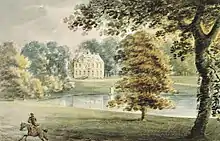Sir William Yonge | |
|---|---|
_-_Sir_William_Yonge_(c.1693%E2%80%931755)%252C_4th_Bt%252C_KB_-_653157_-_National_Trust.jpg.webp) | |
| Member of the British Parliament for Honiton | |
| In office 1715–1754 | |
| Member of the British Parliament for Tiverton | |
| In office 1754–1755[1] | |
| Yonge baronetcy | |
| In office 1731–1755 | |
| Personal details | |
| Born | c. 1693 |
| Died | August 10, 1755 (aged 61–62) |
| Parents |
|

Sir William Yonge, 4th Baronet (c. 1693 – 10 August 1755), KCB FRS PC, of Escot House in the parish of Talaton in Devon, was an English politician who sat in the House of Commons for 39 years from 1715 to 1754.
Origins
Yonge was the son and heir of Sir Walter Yonge, 3rd Baronet, and his second wife Gwen Williams, daughter of Sir Robert Williams, 2nd Baronet of Penryn, Cornwall.[2] He was a great-great-grandson of Walter Yonge (1579–1649), a lawyer, merchant and notable diarist, whose diaries (1604–45) are valuable material for the contemporaneous history of Great Britain.[3]
Career
In 1715 Yonge was returned as Member of Parliament for his family's Rotten Borough of Honiton, in Devon and held the seat until 1754.[1] He was also returned for Tiverton at the general elections of 1727, 1747 and 1754 but only took the seat in 1754. In the House of Commons he attached himself to the Whigs, and making himself useful to Sir Robert Walpole, was rewarded with a commissionership of the Treasury in 1724. King George II, who conceived a strong antipathy to Sir William, spoke of him as "Stinking Yonge"; but Yonge obtained a commissionership of the Admiralty in 1728, was restored to the Treasury in 1730, and in 1735 became Secretary at War. He distinguished himself especially in his defence of the Government against a hostile motion by Pulteney in 1742.[3] He was created KB in 1725.[1]

Making friends with the Pelhams, he was appointed Vice-Treasurer of Ireland for life in 1746. Acting on the committee of management for the impeachment of Lord Lovat in 1747, he won the applause of Horace Walpole by moving that prisoners impeached for high treason should be allowed the assistance of counsel. In 1748 he was elected a Fellow of the Royal Society.[3] He was a founding Governor of the Foundling Hospital, which worked to alleviate the scourge of child abandonment.[1]
He succeeded his father, the 3rd Baronet, in 1731, taking possession of Escot House near Ottery St Mary, Devon, which had been built by his father.[2]
Literary career
Yonge enjoyed some reputation as a versifier, some of his lines being even mistaken for the work of Pope, greatly to the disgust of the latter. He wrote the lyrics incorporated in a comic opera, adapted from Richard Brome's The Jovial Crew, which was produced at the Drury Lane Theatre in 1730 and had considerable success.[3]
Marriages and children
Yonge married in 1716, Mary, the daughter of Samuel Heathcote of Hackney, from whom he was divorced in 1724. At this point they had lived for some time apart and Yonge had a number of extramarital affairs. But when he found out his wife had a lover, too, he took the opportunity to sue his wife's lover for damages, and then as the result of the divorce proceedings he got his wife's dowry and a greater part of her fortune. The case was the inspiration for Lady Mary Montagu to write a poem "Epistle from Mrs Yonge to Her Husband", protesting against the sexual double standard of her era.[4]
By his second wife, Anne Howard, a daughter and coheiress of Thomas Howard, 6th Baron Howard of Effingham, he had two sons and six daughters.[1]
Death
Yonge died at his seat of Escot, near Honiton, on 10 August 1755. He was succeeded in his title and estates by his eldest son Sir George Yonge, 5th Baronet.[2]
References
- 1 2 3 4 5 "YONGE, William (c.1693-1755), of Colyton, Devon". History of Parliament Online. Retrieved 16 August 2018.
- 1 2 3 Cokayne, George Edward, ed. (1903), Complete Baronetage volume 3 (1649–1664), vol. 3, Exeter: William Pollard and Co, retrieved 26 October 2018
- 1 2 3 4 Chisholm 1911.
- ↑ Lipking, Lawrence. Abandoned Women and Poetic Tradition, Chicago: The University of Chicago Press, 1988, p. 10. Google Books
- Yonge family genealogy site
- This article incorporates text from a publication now in the public domain: Chisholm, Hugh, ed. (1911). "Yonge, Sir William". Encyclopædia Britannica. Vol. 28 (11th ed.). Cambridge University Press. p. 922.
External links
- Sir William Yonge at the Eighteenth-Century Poetry Archive (ECPA)
- . Dictionary of National Biography. London: Smith, Elder & Co. 1885–1900.